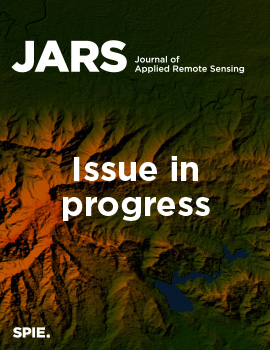Jiang Chen, Weining Zhu, Yong Tian, Qian Yu, Yuhan Zheng, Litong Huang
Journal of Applied Remote Sensing, Vol. 11, Issue 03, 036007, (August 2017) https://doi.org/10.1117/1.JRS.11.036007

TOPICS: Magnesium, Remote sensing, Atmospheric corrections, Reflectivity, Statistical modeling, Atmospheric modeling, Spatial resolution, Data modeling, Error analysis, Satellites
Colored dissolved organic matter (CDOM) and chlorophyll-a (Chla) are important water quality parameters and play crucial roles in aquatic environment. Remote sensing of CDOM and Chla concentrations for inland lakes is often limited by low spatial resolution. The newly launched Sentinel-2 satellite is equipped with high spatial resolution (10, 20, and 60 m). Empirical band ratio models were developed to derive CDOM and Chla concentrations in Lake Huron. The leave-one-out cross-validation method was used for model calibration and validation. The best CDOM retrieval algorithm is a B3/B5 model with accuracy coefficient of determination (R2)=0.884, root-mean-squared error (RMSE)=0.731 m−1, relative root-mean-squared error (RRMSE)=28.02%, and bias=−0.1 m−1. The best Chla retrieval algorithm is a B5/B4 model with accuracy R2=0.49, RMSE=9.972 mg/m3, RRMSE=48.47%, and bias=−0.116 mg/m3. Neural network models were further implemented to improve inversion accuracy. The applications of the two best band ratio models to Sentinel-2 imagery with 10 m×10 m pixel size presented the high potential of the sensor for monitoring water quality of inland lakes.



 Receive Email Alerts
Receive Email Alerts